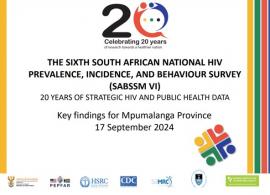
Compared to other provinces, Mpumalanga had the highest HIV prevalence at 17.4% in 2022, which translates to an estimated 890 000 people living with HIV (PLHIV) in the province.
The key findings of the Sixth South African HIV Prevalence, Incidence, and Behaviour Survey (SABSSM VI) for Mpumalanga were released by the Human Sciences Research Council (HSRC) on Tuesday.
According to the overall principal investigator of the study, the HSRC’s Professor Khangelani Zuma, the survey showed that, in 2022, HIV prevalence in the province was 7.8% among youth aged 15 to 24 overall, and 1.5-fold higher among males (9.8%) than females (6.3%) in this age group.
Among adults aged 25 to 49, HIV prevalence was 26.4% overall, and 1.6-fold higher among females (31.9%) than males (19.9%).
By locality, HIV prevalence was higher among those residing in rural formal or farms (21.1%) and rural informal areas (18.4%) and lower in urban areas (15.5%).
“A concerning state is that HIV prevalence peaked at 40.8% among those 45 to 49 years in 2022 compared to 39% in 2017 among those 35 to 39 years, suggesting a possibility of continued new infections.
“There was a notable downward shift in the epidemic curve in 2022 among respondents 15 to 44 years,” Zuma noted.
The data presented are for three priority districts in Mpumalanga, namely Ehlanzeni, Gert Sibande and Nkangala districts.
In 2022, HIV prevalence among all ages was highest in Gert Sibande (20.5%) and Ehlanzeni (16%) and lowest in Nkangala (13.1%).
Antiretroviral treatment
Meanwhile, according to the data, antiretroviral treatment (ART) coverage in Mpumalanga increased to 81.8% in 2022, from 65.4% in 2017.
This translates to an estimated 630 000 people living with HIV in the province receiving ART in 2022.
In 2022, ART use among all people living with HIV in the province was 56.4% among adolescents and youth 15 to 24 years and 83.9% among those 25 to 49 years.
Among females, ART coverage was substantially lower among those aged 15 to 24 (58.6%) than those aged 25 to 49 (85.2%).
ART coverage among males from 25 to 49 years was 81.6%, while it was 54.8% for male youth aged 15 to 24.
The SABSSM VI survey, conducted between 2022 and 2023, aimed to maintain surveillance of HIV infection and behaviours in South Africa, evaluate the progress of the South African national HIV and AIDS, STI and TB Strategic Plan, and monitor HIV indicators for national and international reporting.
Knowledge of HIV status
Zuma expressed concern that people living with HIV aged 25 to 49 accounted for most people living with HIV in Mpumalanga who were unaware of their HIV status (62.3%), aware but not on ART (63.5%), and on ART but not virally suppressed (63.4%).
However, adolescents and youth aged between 15 to 24 contributed disproportionally to gaps in treatment, accounting for just 9.4% of all people living with HIV.
In this age group, 16.9% knew their HIV status, 16.7% knew their HIV status but were not on ART, and 13.7% of those on ART were not on viral load suppression (VLS).
People residing in urban areas accounted for the most people living with HIV overall.
Key drivers
Regarding the key drivers of the HIV pandemic, Zuma noted that Mpumalanga had the lowest prevalence of sexual debut among provinces.
The proportion of adolescents and youth aged 15 who reported having sex before the age of 15 years decreased from 13.3% in 2017 to 5.4% in 2022.
However, sexual debut before the age of 15 among adolescents and youth aged between 15 and 24 in 2022 was higher among males (6.1%) than females (4.8%).
The survey revealed that in the province, 5.1% of people aged 15 and older reported having multiple sexual partners in 2022 compared to 7.9% in 2017.
The proportion of people aged 15 years and older who reported having multiple sexual partners was almost three-fold (7.4%) higher in males than among females (2.7%) and was higher among those aged between 15 and 24 (6.2%) compared to other age groups.
Regarding condom use, the survey revealed that 46.1% reported using a condom with the most recent sexual partner in 2022 compared to 46.3% in 2017.
Condom use was substantially lower among those residing in rural formal or farm dwellings (26.0%) compared to those living in urban areas (50.1%).
Meanwhile, a higher proportion (32.4%) also reported that they never used a condom with their most recent sexual partner.
“Only 11% reported that they used condoms almost every time … Nearly 50% of youth reported using a condom sometimes or never using a condom.” – SAnews.gov.za


